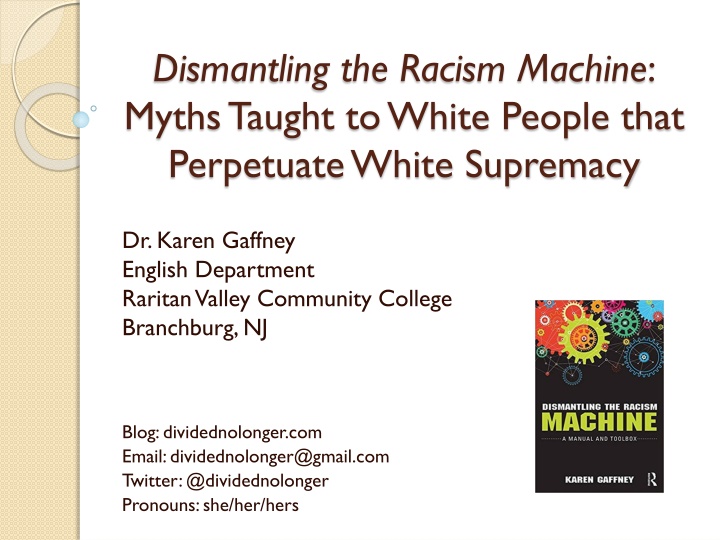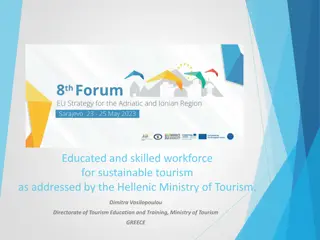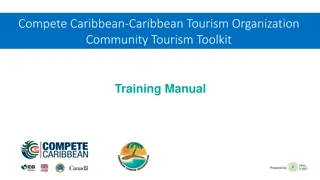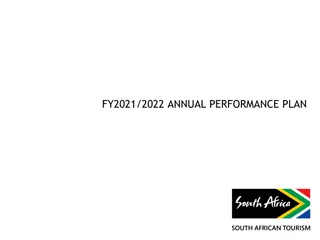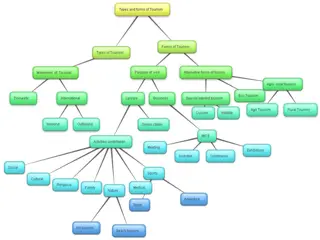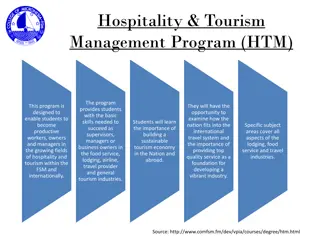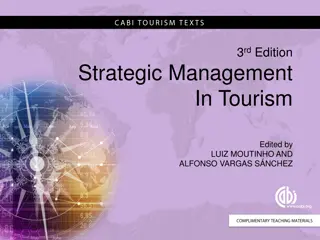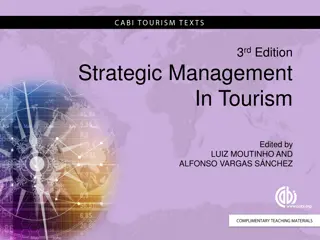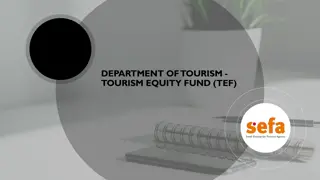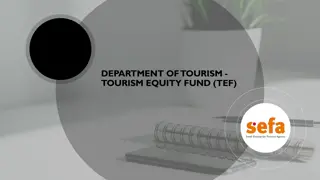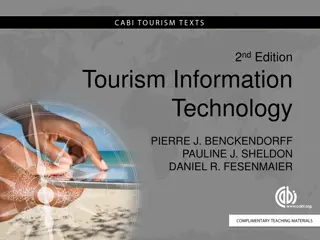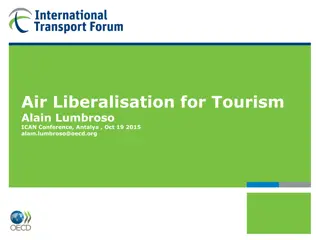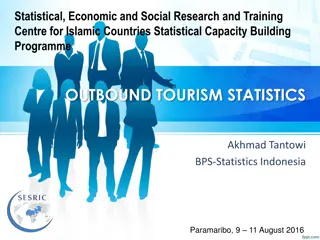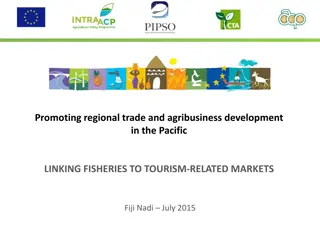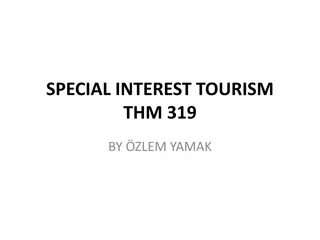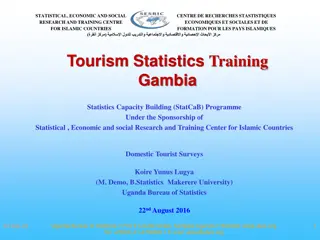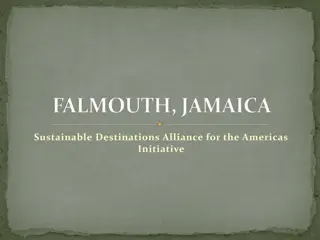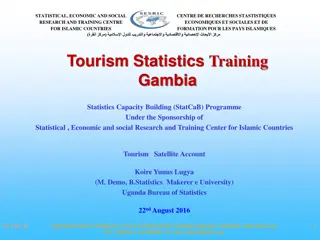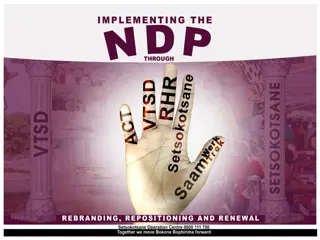Delivering World-Class Tourism Solutions in England
Our focus is on developing and marketing English tourism to drive growth both domestically and internationally. Organisational priorities include supporting the Discover England Fund, investing in overseas networks, and digital content curation. Core capabilities involve brand guardianship, industry support, and delivering bookable tourism products in line with market demands. The Discover England Fund aims to grow tourism in England's regions, increase competitiveness, and create world-class itineraries to meet consumer needs and drive volume.
Download Presentation

Please find below an Image/Link to download the presentation.
The content on the website is provided AS IS for your information and personal use only. It may not be sold, licensed, or shared on other websites without obtaining consent from the author.If you encounter any issues during the download, it is possible that the publisher has removed the file from their server.
You are allowed to download the files provided on this website for personal or commercial use, subject to the condition that they are used lawfully. All files are the property of their respective owners.
The content on the website is provided AS IS for your information and personal use only. It may not be sold, licensed, or shared on other websites without obtaining consent from the author.
E N D
Presentation Transcript
Dismantling the Racism Machine: Myths Taught to White People that Perpetuate White Supremacy Dr. Karen Gaffney English Department Raritan Valley Community College Branchburg, NJ Blog: dividednolonger.com Email: dividednolonger@gmail.com Twitter: @dividednolonger Pronouns: she/her/hers
Introductions Name, preferred pronoun, where you re from Why did you decide to come to this conference? What do you hope to get out of this institute?
Where I begin There is a massive gap between what scholars who study race and racism take for granted and what public (especially white public) knows introductory course on race at my NJ community college local community-based NJ anti-racism coalition community courses and workshops I facilitate in NJ libraries and churches for predominantly white audiences workshops at national conferences As a white anti-racism educator, one contribution I can make is to help bridge the gap My book and my workshops are part of that effort This is my 4thyear presenting at WPC and my first time facilitating an institute
Todays plan Our discussion today from 9am-5pm will center on 3 key myths that white people in particular are often taught that obscure reality of racism We ll break each one down and discuss it; then you ll have opportunity to develop an action plan We ll take breaks periodically, and boxed lunches will be available 12-1pm
Step 1: Chip Away at the False Ideology that Race is Biological Ideology = myth or belief people are unknowingly indoctrinated into believing Power Damaging and false ideology blocks the view of the Racism Machine
Reality Myth #1: Human races are biologically different There are no inherent or biological or genetic differences between groups we call races because race is a social construct (a human invention). Josiah Nott, Types of Mankind, 1854 Human DNA is about 99.9% identical throughout the world No scientific, biological, or genetic way to separate humans into races Washington Post, 2016 Researchers at the University of Virginia quizzed white medical students and residents to see how many believed inaccurate and at times "fantastical" differences about the two races -- for example, that blacks have less sensitive nerve endings than whites or that black people's blood coagulates more quickly. They found that fully half thought at least one of the false statements presented was possibly, probably or definitely true.
Thomas Jefferson, Notes on the State of Virginia (1788) I advance it therefore as a suspicion only, that the blacks, whether originally a distinct race, or made distinct by time and circumstances, are inferior to the whites in the endowments both of body and mind (153). In comparison with whites, black people have a very strong and disagreeable odour (148) are more tolerant of heat, and less so of cold (148) seem to require less sleep (148) are more ardent after their female (148) In imagination they are dull, tasteless, and anomalous (149) Their griefs are transient (148) (see Dismantling the Racism Machine, pages 32-35)
Contemporary examples Washington Post article (2016) In describing his shooting of unarmed black teenager Michael Brown in Ferguson, Missouri on August 9, 2014, white officer Darren Wilson told the grand jury, which did not indict him, And when I grabbed him, the only way I can describe it is I felt like a 5-year-old holding onto Hulk Hogan. . . . [Michael Brown] had the most intense aggressive face. The only way I can describe it, it looks like a demon, that s how angry he looked (qtd. in Calamur). (see Dismantling the Racism Machine, pages 43; 20)
Debunking the myth that race is biological 10 Things Everyone Should Know About Race (handout) #1-5 Quotes from documentary Race: The Power of an Illusion (handout) Article Race DNA by Dr. Joseph Graves (handout) Discussion: What ways of debunking this myth is most helpful to you, and how can you use this moving forward?
Step 2: See the Racism Machine If we chip away at the false ideology that race is biological and recognize the reality that race is a human invention, then the Racism Machine is more visible. We ask: Who built it? When? Why? How?
Reality Myth #2: Race has always existed. Whiteness has always existed. Race is an invention, a relatively recent human invention. One location: Colonial Virginia, 1600s The line between servant and slave was ambiguous People didn t identify as black or white (nationality, language, religion) Skin color was not a dividing line Elite wealthy landowners vs. labor Bacon s Rebellion (1676) Race was invented to protect the elite and divide and conquer the masses through the creation of a racial hierarchy
Ethnocentricity vs. racism From Race: Are We So Different, Goodman et al. 11: To be sure, past peoples were ethnocentric. They frequently believed themselves culturally superior to others and sometimes exhibited the nasty habit of painting others as uncultured and brutish or savage Yet . . . ethnocentric and later racial logics differed significantly. . . . Prior to the inception of race, people were much less likely to link cultural practices instinctively and irrevocably to physical differences Moreover where they deemed others to be culturally backwards in language, religion, food, adornment, or other behaviors, they tended to view these deficits as correctable [R]ace represents an unfortunate shift in primary focus from learned practices and traditions toward static or fixed notions of physical and essential characteristics 10 Things handout, #6 Slavery predates race
Colonial Virginia before race was invented Worsening status of European laborers (who were majority of laborers) in early colonial Virginia (early to mid 1600s) Tenant farmers lost rights and opportunities to get land; large landowners gained power (Theodore Allen, The Invention of the White Race) laws passed to restrict servants movements and reflect fear of them running away and rebelling
Colonial Virginia before race was invented Anthony Johnson, an African man, is enslaved and sent to Virginia in 1621. By 1655, he is free and owns his own land and his own slaves. He takes a nearby European farmer to Virginia court over a dispute and wins. Historian Edmund Morgan: It was common, for example, for servants and slaves to run away together, steal hogs together, get drunk together. It was not uncommon for them to make love together (327) Historian Lerone Bennett Jr.: a great mass of white and black bondsmen, who occupied roughly the same economic category and were treated with equal contempt by the lords of the plantations and legislatures. Curiously unconcerned about their color, these people worked together and relaxed together (qtd. in Michelle Alexander 23) (see Dismantling the Racism Machine, pages 61-63)
Bacons Rebellion (1676) Legal scholar Michelle Alexander: The events in Jamestown were alarming to the planter elite, who were deeply fearful of the multiracial alliance of bond workers and slaves. Word of Bacon s Rebellion spread far and wide, and several more uprisings of a similar type followed (24)
Gathering the raw materials to build the Racism Machine Law, 1662: the children of black women must serve according to the condition of the mother Law, 1691: first time white is used in Virginia law when the children of white women and black or Native American men are identified as abominable mixture and spurious issue ; interracial marriage is banned and such couples are banished (Hening, vol. 3 86-87) (see Dismantling the Racism Machine, pages 65, 66)
Virginia slave codes, 1705 Right to vote, right to serve on a jury, right to hold office were all taken away from black people who had property and were now deemed persons incapable in law Black and Native American slaves are now real estate, permanent slaves, property with no rights Servants are white and receive benefits when their period of indenture is over, including food, money, weapons; they can go to court if not treated well (see Dismantling the Racism Machine, pages 68-70)
Whiteness whiteness defined through European ancestry was a calculated racial solution developed by colonial leaders to the economic and physical threat of laboring-class solidarity (Goodman et al. 44). Michelle Alexander refers to this strategy as a racial bribe, in which white laborers were given a bribe, whiteness, in order to turn against black slaves (25): Deliberately and strategically, the planter class extended special privileges to poor whites in an effort to drive a wedge between them and black slaves. White settlers were allowed greater access to Native American lands, white servants were allowed to police slaves through slave patrols and militias, and barriers were created so that free labor would not be placed in competition with slave labor. These measures effectively eliminated the risk of future alliances between black slaves and poor whites. . . . Their own plight had not improved much, but at least they were not slaves (25).
Step 2: See the Racism Machine, continued White: built with benefits and attached to freedom, connected to civilization, humanity, and a newly blended European identity Black: built by removing rights and chained to chattel slavery and the status of animal with a blending of distinct African nationalities and cultures Native: built by blending distinct indigenous nations into one group often seen as savage and without national identity, with limited or no rights, especially not to the land
Step 3: Examine the Racism Machine s Powerful Mechanisms Ideology of white supremacy was built into the creation of this nation and normalized through every system (law, housing, finance, education, media, etc.) Asian Americans and Latinx people occupied various intermediary positions in the racial hierarchy depending on the moment Mechanisms of laws and government policies carried out these ideologies: slavery, citizenship for whites only, Indian Removal, Manifest Destiny, Chinese Exclusion, Jim Crow segregation, convict leasing, immigration restrictions, bans on interracial marriage, and more
Discussion What ways of debunking the myths that race has always existed and that whiteness has always existed is most helpful to you? How can you use this moving forward?
Today Myth #3: Racism occurred in the past, but that problem has been resolved Reality Systemic racism is a serious problem in the US today. Slavery is over. Mass incarceration, police violence, pollution, maternal and infant mortality, inadequate school resources, poverty, over-surveillance, under- representation, etc. disproportionately impact people of color today. The civil rights movement ended racism. We elected a black President, so racism must be over.
Step 4: Analyze the Racism Machines Recalibration after the Civil Rights Movement Backlash against civil rights movement included many powerful divide and conquer strategies: model minority stereotype of Asian Americans December 26, 1966, U.S. News & World Report, Success Story of One Minority Group in U.S. At a time when Americans are awash in worry over the plight of racial minorities One such minority, the nation s 300,000 Chinese-Americans, is winning wealth and respect by dint of its own hard work
Step 4: Analyze the Racism Machines Recalibration after the Civil Rights Movement Backlash against civil rights movement included many powerful divide and conquer strategies: African Americans stereotyped as: welfare queens (myth of welfare fraud leads to cuts to social services) In 1976, Ronald Reagan told a campaign rally She has eighty names, thirty addresses, twelve Social Security card (Zucchino 64-65) dangerous criminals (myth of criminality leads to mass incarceration during the War on Drugs) Today: I feared for my life ; I m calling the cops
Step 4: Analyze the Racism Machines Recalibration after the Civil Rights Movement Backlash against civil rights movement included many powerful divide and conquer strategies: Latinx people stereotyped as illegal and not American Muslims stereotyped as terrorists Rise in anti-Semitism Myth of voter fraud leads to voting restrictions All of these divide and conquer strategies are fueled by white fear of becoming the minority (Census)
Step 5: Take Apart the Racism Machine Recognize how people, especially white people, have been manipulated to believe pervasive false racial ideologies that are in the very air we breathe White people are often not aware of systemic, unearned advantages they have (white privilege) so they respond to idea of white privilege by saying they aren t privileged and that they worked hard for what they have
In addition to white people not understanding and often denying white privilege, they ve also been taught It s not polite to talk about race Or if you do talk about race, it s appropriate to say I don t see race or I m colorblind It s better if I say nothing about race rather than talk about it for fear of saying the wrong thing Race is something other people have who aren t white White people are individuals not a group These beliefs lead to white fragility (Robin DiAngelo), a defensiveness when confronted with conversations about racism and reality of racism
Step 5: Take Apart the Racism Machine Confront the reality of the Racism Machine, how race was invented to divide and conquer, how our nation and institutions developed around that fundamental racial ideology Become undivided and unconquered Center the voices, experiences, and leadership of those who are marginalized - only when the most marginalized are free are we all free
Discussion & Action Planning What ways of debunking the third myth that racism occurred in the past but that problem has been resolved is most helpful to you? How can you use this moving forward? Reflecting on our whole day: Out of the 3 myths discussed today, which one might you be able to address in your work, your community, or your organization? What are some concrete steps you can plan out to address that myth? What is a timeline? Do you want to exchange contact info with an accountability partner here so you can help each other follow your plan? Share your plans, ask questions, and get feedback
Thank you Dismantling the Racism Machine: A Manual and Toolbox is available: routledge.com - use the code X001 during checkout for 20% off until March 28 Amazon Ask your local library and bookseller to stock it My blog dividednolonger.com has this Powerpoint and many resources Email me: dividednolonger@gmail.com Follow me on Twitter: @dividednolonger Informal evaluation that will help me plan future workshops
